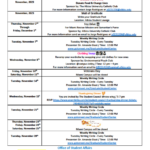By: Rita M. Rivera – AU PsyD Student, Student Learning Assistant – Title V Student Success
The American Psychological Association (APA) style is generally used for scientific communication. APA style sets a standard that is used in many APA journals, books, and electronic databases.
APA style is generally used in different fields, such as psychology, business, and nursing. It can also be used to format research papers. Remember to consult with your professor or refer to your course syllabus to make sure that your assignment needs to be written in APA style.
In order to format a paper in APA style (seventh edition), the following guidelines should be followed:
Aspect 1: Font Style and Size & Margins
- APA style recommends essays to be typed and double-spaced on standard-sized paper (8.5” x 11”).
- Make sure that your document’s margins are 1 inch on all sides.
- In regards to font style and size, APA
style requires to use a font consistently throughout the paper.
- A common used font is 12-point Times New Roman.
- Other acceptable fonts include 11-point Calibri, 11-point Arial, 10-point Lucida Sans Unicode, 11-point Georgia, and 10-point Computer Modern.
Aspect 2: Title Page (Student Papers)

- The seventh edition of APA style provides slightly different directions for formatting title pages of professional papers and student papers.
- For student papers, the first page should have a title page that includes the following information:
- The page number on the upper right corner of the first page. Page numbers should begin on the first page and follow on every subsequent page. No other information is required.
- The title of the paper should be centered, bold, and written in title case. The title should be three or four lines below the top margin of the page.
- The author’s name should be two lines below the title. Author’s name should be written as follows: First name, Middle Initial(s), Last Name.
- The author’s institutional affiliation should be under the author’s name. This usually corresponds to the department containing the course for which the paper is being written and the institution’s name (e.g. Department of Clinical Psychology, Albizu University).
- The number and name of the course should be under the institutional affiliation.
- The instructor’s name and the due date of the assignment should be under the name of the course.
- Note that running heads are no longer part of student papers in the seventh edition of APA style.
Aspect 3: Body Pages
- Usually, after the cover page, the pages that follow are those with the content of the essay.
- These pages should also have page numbers in the upper right corner.
- The title of the paper should be bolded and centered above the first body paragraph.
Aspect 4: Level Headings
- In APA style, there are 5 different heading levels that you can use. These can be considered styling formats for subtitles and sub headers. Level headings classify a paper into sections.
- Regardless of the number of levels, always use the headings in order, beginning with level 1.
- The format of each level is the following:

Aspect 5: Citations
- Remember to cite all paraphrased and copied information in both a Reference(s) page [write Reference when there is only one source being cited] and in in-text citations.
- Citations in APA depend on the type of source of the material being used (e.g. books, scholarly articles, websites).
- You can refer to the Tutoring Lab at Albizu University, an APA Handbook, or https://owl.english.purdue.edu/owl/ for specific instructions on how to cite different sources in APA.
As previously mentioned, APA style can be used when writing research papers. Make sure to stay tuned for our next post on The Recipe for an Effective Research Paper!
References:
American Psychological Association. (2020). Publication Manual of the American Psychological Association: 7th edition. Washington, DC: American Psychological Association.
Myers, M., Paiz, J., Angeli, E., Wagner, J., Lawrick, E., Moore, K., Anderson, M.,…Keck, R. (2019, December 20). General format. Purdue Online Writing Lab. https://owl.purdue.edu/owl/research_and_citation/apa_style/apa_formatting_and_style_guide/general_format.html









